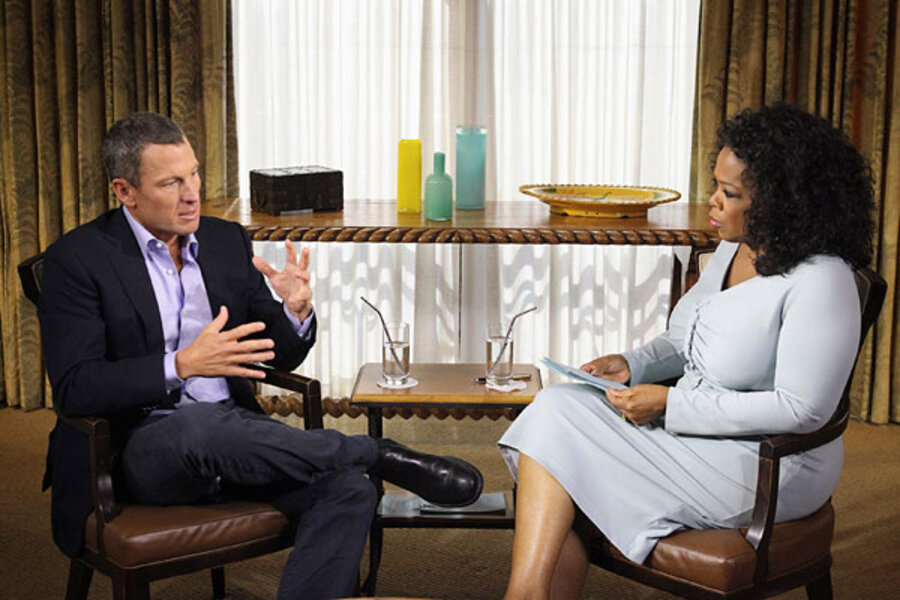Oprah interview: Can Lance Armstrong rehabilitate his image?
Loading...
| Los Angeles
Can Lance Armstrong rehabilitate his image?
Yes, say public relation and image specialists. Think Marion Barry – the Washington mayor caught on video smoking crack in a room with a prostitute, who came back to be reelected. Or Bill Clinton, who was dubbed “the comeback kid” for politically surviving sexual peccadilloes more than once. Or Tiger Woods, who is now the No. 2 ranked golfer in the world and who may regain some sponsorships.
Americans are extremely forgiving, they say.
For Lance Armstrong, however, the list of “yes, buts” is long, including both image and legal problems. His repeated denials of having used performance-enhancing drugs, together with his efforts to legally and emotionally bully those who suggested otherwise, make him a particularly hard case.
The issue arises because Armstrong reportedly confessed to using performance-enhancing drugs in an interview with Oprah Winfrey that will air in a two-part special Thursday and Friday on Winfrey’s OWN network. In October, Armstrong was slapped with a lifetime ban from professional cycling on the heels of a 1,000-page report last year by the United States Anti-Doping Agency (USADA). The report chronicled an elaborate, 15-years-long doping program led by Armstrong and involving a long list of performance enhancers from steroids to blood boosters such as EPO.
“To rehabilitate his image, he needs to do many things, and he must do them without a quid pro quo that it will lead to any exoneration,” says Len Shyles, professor of communication at Villanova University. “He owes many apologies to many individuals and interests. Unfortunately a liar, a cheat, and a thief, he defrauded businesses and people of millions of dollars and some may have been severely damaged. He systematically ruined the lives of other cyclists and private citizens, costing them their reputations and many dollars defending themselves from lawsuits.”
Where Armstrong must begin, say several analysts, is reestablishing some small measure of trust and integrity.
"These top athletes are perceived as role models and when they fail to maintain that level of trust, it’s difficult to get it back. Pete Rose is a great example. One of history’s greatest baseball players, but he’s been perhaps permanently scarred by his gambling,” says Mitch Leff, president of Leff & Associates, a public-relations firm in Atlanta. “People will forgive someone who makes a mistake, or does something illegal or unethical, if they admit what they did and show a real effort to change. But when someone lies for years and years, in interview after interview, it is very difficult to forgive.”
That means Armstrong must come across as absolutely sincere – an immense challenge based on his past.
“In his interview with Oprah – and in others that may follow – he must be perceived as genuinely contrite about his past mistakes and not just using the opportunity as a springboard to other pursuits,” says Richard Goedkoop, retired professor of communication at LaSalle University. “This will be a challenge since his denials on this subject go back at least 10 years. Why should we believe he is sincere now?”
One huge factor in his favor, say Goedkoop and others, is Armstrong’s long association with the Livestrong cancer charity he founded and ran for a number of years as a well-known cancer survivor himself. For that reason, many people want Armstrong to succeed because he is their genuine hero.
But first he must show that he is aware – and sorry for – the damage that he caused.
“He has to admit guilt and apologize but also needs to show that he is sorry and be perceived by the public as having paid a price,” says Gene Grabowski, executive vice president of Levick, an image relations firm. “He needs to claim responsibility and not blame others, otherwise the resistance will continue to undermine his chances of acceptance and redemption.”
One way to show contrition, says Mr. Leff, would be to become a leading voice in world antidoping efforts.
“He needs to become the poster child for sports drug testing, and he needs to be a voice that tells young athletes that they can compete without drugs,” he says.
Indeed, some say Armstrong has done the greatest damage to sport itself.
“The biggest public-relations loss here is not to Lance Armstrong, but to the sport of cycling and, more broadly, sport overall,” says Michael Smith, a professor of communication at La Salle University. “Unlike Tiger Woods and Arnold Schwarzenegger, whose transgressions were personal failures unrelated to playing golf or governing, Armstrong’s doping went straight to the heart of his sport. For Tiger and Arnold, the PR damage was personal. Still long-lasting, still personally costly both monetarily and in public support, but contained their personal reputations.”
What's more, it could get worse. Questions linger about whether officials at cycling's governing body, the UCI, helped cover up the scandal.
For his part, Armstrong faces problems well beyond his image. He could be forced to return substantial sponsorship fees and pay a hefty fine.
Given the 15 years of transgressions and the many, oft-replayed denials of wrong doing, many analysts say Armstrong's climb to public redemption might be too steep.
“He had ample opportunity to come clean, make his apologies, and accept the consequences of his actions. Had he done so, he may have found redemption. But he did not. And as far as I am able to determine, he continues to blame the sport and the officials involved in its oversight for his behavior,” says Gordon Coonfield, a professor of communication at Villanova University.
“Perhaps everyone [dopes]," he adds. "And if so, that would certainly make his apology, with its caveats, more compelling. But he didn't just dope. He lied. And he sought actively to humiliate and discredit anyone who called him on it. He used his power, popularity, and connections to hurt people in order to silence them. This is, if not unforgivable, at least unpardonable.”





